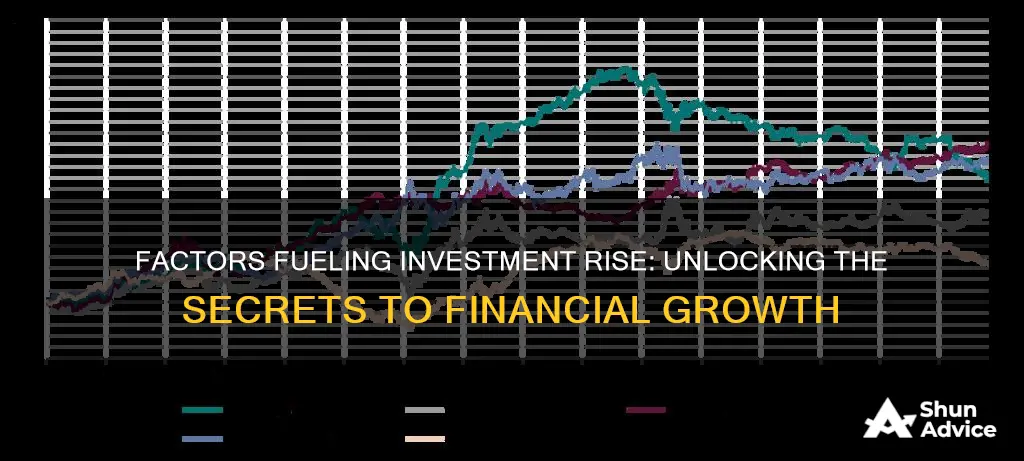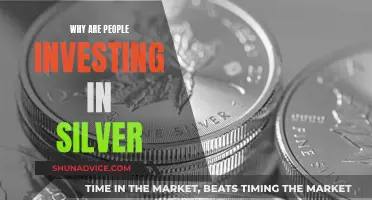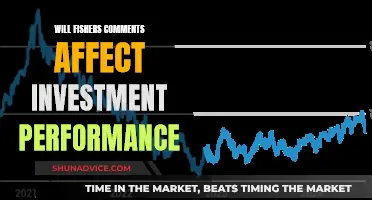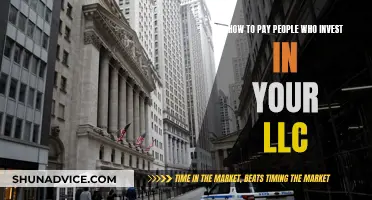
There are many factors that can cause investment to rise. Firstly, lower interest rates tend to increase the quantity of investment, while higher interest rates reduce it. This is because higher interest rates increase the opportunity cost of using funds for investment. In addition, public policy can also affect investment. Government agencies invest in the public stock of capital, and tax and regulatory policies can also influence the investment choices of private firms and individuals. For example, lower taxes on corporate profits can encourage greater capital accumulation.
Furthermore, expectations about future sales and profitability play a crucial role in investment decisions. Positive expectations about future sales and profitability can increase investment demand, while expectations of reduced profitability can decrease it. The level of economic activity is another factor, as an increase in GDP will likely boost demand for capital and lead to greater investment.
The cost of capital goods is another determinant of investment. If the cost of capital goods increases, the quantity of investment at any interest rate is likely to fall. Technological changes can also increase the demand for capital and stimulate investment. Finally, the capacity utilisation rate can influence investment decisions, as firms are more likely to invest when a large percentage of the current capital stock is being utilised.
| Characteristics | Values |
|---|---|
| Interest rates | Lower interest rates increase investment |
| Expectations | Expectations of higher future returns from investment shift the investment demand curve to the right |
| Level of economic activity | An increase in GDP will shift the investment demand curve to the right |
| Stock of capital | A larger stock of capital can reduce investment |
| Capacity utilization | A higher capacity utilization rate will increase investment |
| Cost of capital goods | A higher cost of capital goods will reduce investment |
| Other factor costs | A higher cost of labour will increase investment |
| Technological change | The implementation of new technology will increase investment |
| Public policy | Public policy that reduces the cost of capital for firms will increase investment |
What You'll Learn

Interest rates
On the other hand, when interest rates fall, companies benefit from reduced borrowing costs, which can stimulate economic growth and corporate borrowing. This environment often leads to greater profits and a more robust economy, positively impacting stock prices. It is worth noting that the financial sector tends to be an exception to the rule, as higher interest rates can boost earnings for banks, brokerages, mortgage companies, and insurance companies due to increased lending rates.
Now, let's turn our attention to the bond market. Interest rates and bond prices share an inverse relationship. When interest rates rise, bond prices tend to fall, and vice versa. This relationship is influenced by the risk-free rate, which is the return on investments considered free of default risk, such as government securities. As interest rates rise, the risk-free rate increases, making these investments more attractive. As a result, investors may shift their money from stocks to these safer alternatives, causing a potential decline in stock prices.
Additionally, the impact of interest rates on savings accounts and certificates of deposit (CDs) is worth considering. When interest rates increase, the annual percentage yield (APY) on CDs and savings accounts tends to rise, making them more appealing to risk-averse investors. However, it's important to remember that short-term interest rate changes may not significantly affect long-term investment horizons, especially for investors with well-diversified portfolios.
Real estate investments are also influenced by interest rates. When interest rates rise, the cost of financing purchases, such as mortgages, increases, making real estate less affordable for potential buyers. Consequently, real estate prices may be pressured downward. On the flip side, when interest rates fall, real estate becomes more affordable, potentially driving up prices.
In summary, interest rates play a crucial role in investment decisions across various asset classes. Rising interest rates can pressure stock prices, bond prices, and real estate values, while making savings accounts and CDs more attractive. Conversely, falling interest rates can stimulate economic growth, boost corporate earnings, and positively impact stock prices and real estate values. However, it's important to remember that the impact of interest rates is complex and can vary across different sectors and asset classes.
Strategic Enterprise Financing: Navigating Investment Opportunities
You may want to see also

Expectations
In summary, expectations are a key driver of investment decisions, and changes in expectations can lead to shifts in the investment demand curve. Businesses base their investment strategies on their outlook for profitability, inventory management, taxation, technology, and market conditions. By assessing and managing these expectations, businesses can make more informed decisions about their investments.
Retirement Redefined: Navigating the Investment Landscape for a Secure Future
You may want to see also

Level of economic activity
The level of economic activity is a key determinant of investment demand. An increase in the level of production will likely boost demand for capital and, thus, lead to greater investment. This is because firms need capital to produce goods and services.
An increase in GDP, for example, will likely shift the investment demand curve to the right. This is because an increase in GDP will boost investment, and the multiplier effect of an initial change in one or more components of aggregate demand will be enhanced.
For instance, an increase in production that occurs with an initial increase in aggregate demand will increase household incomes, which will, in turn, increase consumption, thus producing a further increase in aggregate demand. If the increase also induces firms to increase their investment, this multiplier effect will be even stronger.
The level of economic activity is also closely linked to the business cycle, which is a recurring pattern of increasing and decreasing economic activity. The business cycle is part of the overall level of economic activity topic in IB Economics.
The level of economic activity is just one of many factors that influence investment demand. Other factors include expectations, the stock of capital, capacity utilization, the cost of capital goods, other factor costs, technological change, and public policy.
Final Countdown: Strategic Investments for the Retirement Rush
You may want to see also

Stock of capital
The stock of capital is a crucial macroeconomic concept, referring to the total value of a company's or economy's capital assets. It includes physical capital, such as buildings and machinery, as well as financial capital, such as common and preferred shares issued by a company.
Components of Stock of Capital:
- Physical Capital: This includes tangible assets like buildings, machinery, equipment, and structures owned by a company or used within a particular economy to produce goods and services.
- Financial Capital: This pertains to the amount of common and preferred shares that a company is authorised to issue according to its corporate charter. It represents the maximum number of shares the company can have outstanding, and it is listed on the company's balance sheet under shareholders' equity.
Factors Influencing Stock of Capital:
- Investment Decisions: Investment in new capital goods, plant, equipment, and intellectual property directly impacts the stock of capital. Companies may choose to invest in additional capital assets to expand their operations or replace outdated ones.
- Depreciation and Depletion: Over time, capital assets may depreciate in value due to wear and tear or become obsolete due to technological advancements. This depletion of the capital stock can affect a company's or economy's overall productivity and output.
- Interest Rates: Lower interest rates can incentivise firms to take out loans or issue bonds to invest in their capital stock. Higher interest rates may deter investment as borrowing becomes more costly.
- Economic Conditions: During economic slumps, investment in capital stock tends to decline sharply, leading to a depleted capital stock. Conversely, during periods of economic growth, companies may have more capital available to invest in expanding their capital assets.
- Innovation and Technology: Technological advancements can influence the stock of capital. Companies may invest in new technologies to enhance their operations, replace outdated equipment, or stay competitive.
- Government Policies: Government policies, such as tax incentives or subsidies, can impact a company's or industry's ability to invest in their capital stock. Additionally, government purchases and transfers can influence the overall investment climate.
Implications of Stock of Capital:
The stock of capital plays a significant role in a company's or economy's ability to produce goods and services. A larger stock of capital can indicate greater productive capacity, while a depleted or stagnant stock of capital may hinder economic growth.
In summary, the stock of capital is a dynamic concept influenced by various factors, including investment decisions, economic conditions, technology, and government policies. It encompasses both physical and financial capital, and it plays a crucial role in determining the productive capacity of companies and economies.
Commodities: Invest Now or Later?
You may want to see also

Capacity utilisation
A capacity utilisation rate of under 100% indicates that the organisation is producing below its full potential. For example, a company that is currently producing 10,000 widgets at a cost of $0.50 but has the capacity to produce 15,000 widgets without an increase in cost per unit, would have a capacity utilisation rate of 67%.
The capacity utilisation rate is a key metric for businesses and national economies as it provides insight into the value of production and resources being used at a given time. It can be used to determine how much production can be increased without the need to invest in new equipment, property, or infrastructure. This is particularly relevant for industries that produce physical products rather than services, as these are easier to quantify.
In the context of investment, a high capacity utilisation rate indicates that an organisation is producing as much as it can with its current resources. If leaders do not anticipate greater demand and invest in expanding their capacity, their competitors will fill the gap in the market. Therefore, a high capacity utilisation rate can lead to increased investment to avoid being outcompeted.
A reduction in the capacity utilisation rate indicates an economic slowdown, while an increase signifies economic expansion. Economists use the rate as an indicator of inflationary pressures. A low capacity utilisation rate will result in decreasing prices due to excess capacity and insufficient demand.
Many capitalist economies face high excess capacity rates, and economists use this as an argument against capitalism, stating that resources are not allocated efficiently. However, it is important to note that a capacity utilisation rate of 100% is not sustainable in the long run, as businesses would need to expand their production capacity to increase revenues.
The Fine Line: When Investments Invalidate a Will
You may want to see also
Frequently asked questions
There is a negative relationship between the interest rate and the level of investment. Higher interest rates tend to reduce the quantity of investment, while lower interest rates increase it.
An increase in the level of production is likely to boost demand for capital and thus lead to greater investment. Therefore, an increase in GDP is likely to shift the investment demand curve to the right.
If the construction cost of new buildings rises, then the quantity of investment at any interest rate is likely to fall. The investment demand curve thus shifts to the left.
If a large percentage of the current capital stock is being utilised, firms are more likely to increase investment than they would if a large percentage of the capital stock were sitting idle. During recessions, the capacity utilisation rate tends to fall, depressing investment further.
The implementation of new technology often requires new capital. Changes in technology can thus increase the demand for capital and shift the investment demand curve to the right.







